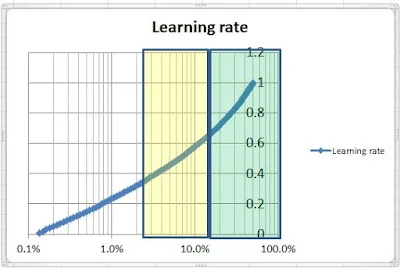I had a conversation over lunch and the other party asked me to throw a few notes onto the ERJ blog/archive.
As a blogger, I am always on the look-out for a meaty topic.
What do teachers do?
It is impossible to evaluate a teacher until you have a usable definition of what they do.
One educator who I consulted said that "Journeymen" teachers make the biggest difference for the middle +/- one standard deviation (70%-ish of the population). The students who are more than +1.0 standard deviations in capability are capable of teaching themselves.
My expert also claimed that the difference between a "Journeyman" and a "Master" teacher is that the Master teachers make a huge difference for those students who fall between -1.0 standard deviations and -2.0 standard deviations. That would be the population between the 2.5th percentile student and the 15th percentile student.
Presented in cumulative fashion:
 |
| Looking solely at the "at risk" end of the curve. Note that the horizontal axis is Log scale. |
A 50%-ile student should be capable of making 1.0 years of growth in 9.5 months of schooling. If the distribution of student abilities is "normal" or bell shaped, it is plausible to assume that a 10% student is capable of 0.65 years of learning in 9.5 months of instruction.
The light green area is where "Journeymen" teachers do their heavy lifting. Master teachers also do their heavy lifting in the green region but extend it to include the yellow area.
Implicit in this approach is that avoiding failures is more important than producing a few superstars. That is, a teacher who sends three students a year to Princeton but has 70% of their students taking a year of remedial classes at Local Community College is not as good of a teacher who has all of their students going to Local State University and only 10% of them taking remedial classes.
Where this model falls short
Evaluating a teacher is more like evaluating a system of lenses (in a camera or rifle scope, for example) than it is a "typical" industrial process.
A system of lenses is evaluated for chromatic aberration, depth of field, distortions, phantom images and so on. Basically, every ray of light entering the system of lenses has the possibility of being processed with fidelity or it can be warped.
"Instruction", the system of lenses, is an amalgamation of many, many processes.
Let me put some meat on the bones.
- A teacher might be great at teaching students who are girls but fail when teaching cis-boys.
- A teacher might be successful at teaching straight students but be a dismal failure attempting to teach kids who identify as gay.
- A teacher might be very successful teaching one race but alienate others.
- Similarly, a teacher might deliver better learning, or grades, to students of one faith at the expense of those who practice a different faith.
- A teacher might be effective teaching "regular" ed but fail abysmally when teaching kids with disabilities.
These sub-groupings were chosen because there is Federal Law that mandates equal opportunity regardless of gender, orientation, race, religious affiliation, or disability.
I propose that teaching each one of these sub-groups is a separate process BECAUSE most kids are very sensitive to "acceptance" and will refuse to perform for instructors who do not accept them. Furthermore, I propose that failing to deliver learning to any of these groups is a failure, both professionally and a failure to comply with Federal Law.
---To be continued---
No comments:
Post a Comment
Readers who are willing to comment make this a better blog. Civil dialog is a valuable thing.